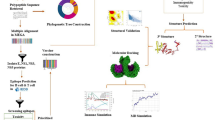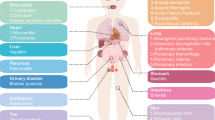Abstract
Foot-and-mouth disease (FMD) is a major threat to the livestock industry worldwide. Despite constant surveillance and effective vaccination, the perpetual mutations of the foot-and-mouth disease virus (FMDV) pose a huge challenge to FMD diagnosis. The immunodominant region of the FMDV VP1 protein (residues 131–170) displayed on phage T7 has been used to detect anti-FMDV in bovine sera. In the present study, the functional epitope was further delineated using amino acid sequence alignment, homology modelling and phage display. Two highly conserved regions (VP1145–152 and VP1159–170) were identified among different FMDV serotypes. The coding regions of these two epitopes were fused separately to the T7 genome and displayed on the phage particles. Interestingly, chimeric phage displaying the VP1159–170 epitope demonstrated a higher antigenicity than that displaying the VP1131–170 epitope. By contrast, phage T7 displaying the VP1145–152 epitope did not react significantly with the anti-FMDV antibodies in vaccinated bovine sera. This study has successfully identified a smaller functional epitope, VP1159–170, located at the C-terminal end of the structural VP1 protein. The phage T7 displaying this shorter epitope is a promising diagnostic reagent to detect anti-FMDV antibodies in vaccinated animals.




Similar content being viewed by others
References
Acharya R, Fry E, Stuart D, Fox G, Rowlands D, Brown F (1990) The structure of foot-and-mouth disease virus: implications for its physical and biological properties. Vet Microb 23:21–34. https://doi.org/10.1016/0378-1135(90)90134-H
Adams MH (1959) Assay of phages by the agar layer method. In: Adams MH (ed) Bacteriophages, 1st edn. Interscience Publishers, New York, pp 450–451
Alexandersen S, Mowat N (2005) Foot-and-mouth disease: host-range and pathogenesis. Curr Top Microbiol Immunol 288:9–42
Alexandersen S, Zhang Z, Donaldson AI, Garland AJM (2003) The pathogenesis and diagnosis of foot-and-mouth disease. J Comp Pathol 129:1–36. https://doi.org/10.1016/S0021-9975(03)00041-0
Baxt B, Becker Y (1990) The effect of peptides containing the arginine-glycine-aspartic acid sequence on the adsorption of foot-and-mouth disease virus to tissue culture cells. Virus Genes 4:73–80
Biasani M, Bienert S, Waterhouse A, Arnold K, Studer G, Schmidt T, Kiefer F, Gallo Cassarino T, Bertoni M, Bordoli L, Schwede T (2014) SWISS-MODEL: modelling protein tertiary and quaternary structure using evolutionary information. Nucleic Acids Res 42:252–258. https://doi.org/10.1093/nar/gku340
Carrillo C (2012) Foot-and-mouth disease virus genome. In: Garcia ML, Romanowski V (eds) Viral genomes-molecular structure, diversity, gene expression mechanisms and host-virus interactions, 1st edn. InTech, Rijeka, pp 53–68
Clavijo A, Wright P, Kitching P (2004) Developments in diagnostic techniques for differentiating infection from vaccination in foot-and-mouth disease. Vet J 167:9–22. https://doi.org/10.1016/S1090-0233(03)00087-X
Colling A, Morrissy C, Barr J, Meehan G, Wright L, Goff W, Gleeson LJ, van der Heide B, Riddell S, Yu M, Eagles D, Lunt R, Khounsy S, Than Long NG, Phong Vu P, Than Phuong N, Tung N, Linchongsubongkoch W, Hammond J, Johnson M, Johnson WO, Unger H, Daniels P, Crowther JR (2014) Development and validation of a 3ABC antibody ELISA in Australia for foot and mouth disease. Aust Vet J 92:192–199. https://doi.org/10.1111/avj.12190
Crowther JR, Farias S, Carpenter WC, Samuel AR (1993) Identification of a fifth neutralizable site on type O foot-and-mouth disease virus following characterization of a single and quintuple monoclonal antibody escape mutants. J Gen Virol 74:1547–1553. https://doi.org/10.1099/0022-1317-74-8-1547
Curry S, Fry E, Blakemore W, Abu-Ghazaleh R, Jackson T, King A, Lea S, Newman J, Rowlands D, Stuart D (1996) Perturbations in the surface structure of A22 Iraq foot-and-mouth disease virus accompanying coupled changes in host cell specificity and antigenicity. Structure 4:135–145. https://doi.org/10.1016/S0969-2126(96)00017-2
de Jong WW, Zweers A, Cohen LH (1978) Influence of single amino acid substitutions on electrophoretic mobility of sodium dodecyl sulfate-protein complexes. Biochem Biophys Res Commun 82:532–539. https://doi.org/10.1016/0006-291x(78)90907-5
Eshaghi M, Tan WS, Ong ST, Yusoff K (2005) Purification and characterization of Nipah virus nucleocapsid protein produced in insect cells. J Clin Microbiol 43:3172–4177. https://doi.org/10.1128/JCM.43.7.3172-3177.2005
Forss S, Strebel K, Beck E, Schaller H (1984) Nucleotide sequence and genome organization of foot-and-mouth disease virus. Nucleic Acids Res 12:6587–6601. https://doi.org/10.1093/nar/12.16.6587
Fowler VL, Bashiruddin JB, Maree FF, Mutowembwa P, Bankowski B, Gibson D, Cox S, Knowles N, Barnett PV (2011) Foot-and-mouth disease marker vaccine: cattle protection with a partial VP1 G-H loop deleted virus antigen. Vaccine 29:8405–8411. https://doi.org/10.1016/j.vaccine.2011.08.035
Guex N, Peitsch MC (1997) SWISS-MODEL and the Swiss-PdbViewer: an environment for comparative protein modelling. Electrophoresis 18:2714–2723. https://doi.org/10.1002/elps.1150181505
Hamblin C, Barnett IT, Hedger RS (1986) A new enzyme-linked immunosorbent assay (ELISA) for the detection of antibodies against foot-and mouth disease virus. I. Development and method of ELISA. J Immunol Methods 93:115–121. https://doi.org/10.1016/0022-1759(86)90441-2
Jamal SM, Belsham GJ (2013) Foot-and-mouth disease: past, present and future. Vet Res 44:116–129. https://doi.org/10.1186/1297-9716-44-116
Kho CL, Tan WS, Yusoff K (2002) Cloning and expression of the phosphoprotein gene of Newcastle disease virus in Escherichia coli. J Biochem Mol Biol Biophys 6:117–121. https://doi.org/10.1080/10258140290027252
Kitson JDA, McCahon D, Belsham GJ (1990) Sequence analysis of monoclonal antibody resistant mutants of type O foot-and-mouth disease virus: evidence for involvement of the three surface exposed capsid proteins in four antigenic sites. Virology 179:26–34. https://doi.org/10.1016/0042-6822(90)90269-W
Klein J (2009) Understanding the molecular epidemiology of foot-and-mouth-disease virus. Infect Genet Evol 9:153–161. https://doi.org/10.1016/j.meegid.2008.11.005
Knight-Jones TJD, Rushton J (2013) The economic impacts of foot-and-mouth disease—what are they, how big are they and where do they occur? Prev Vet Med 112:161–173. https://doi.org/10.1016/j.prevetmed.2013.07.013
Krezel AM, Wagner G, Seymour-Ulmer J, Lazarus RA (1994) Structure of the RGD protein decorsin: conserved motif and distinct function in leech proteins that affect blood clotting. Science 264:1944–1947. https://doi.org/10.1126/science.8009227
Lazarus RA, McDowell RS (1993) Structural and functional aspects of RGD-containing protein antagonists of glycoprotein IIb-IIa. Curr Opin Struct Biol 4:438–445. https://doi.org/10.1016/0958-1669(93)90009-L
Logan D, Abu-Ghazaleh R, Blakemore W, Curry S, Jackson T, King A, Lea S, Lewis R, Newman J, Parry N, Rowlands D, Stuart D, Fry E (1993) Structure of a major antigenic site on foot-and-mouth disease virus. Nature 362:566–588. https://doi.org/10.1038/362566a0
Ma LN, Zhang J, Chen HT, Zhou JH, Ding YZ, Liu YS (2011) An overview on ELISA techniques for FMD. Virol J 8:419–427. https://doi.org/10.1186/1743-422X-8-419
Mackay DK, Bulut AN, Rendle T, Davidson F, Ferris NP (2001) A solid-phase competition ELISA for measuring antibody to foot-and-mouth disease virus. J Virol Methods 97:33–48. https://doi.org/10.1016/S0166-0934(01)00333-0
Netter HJ, Macnaughton TB, Woo WP, Tindle R, Gowans EJ (2001) Antigenicity and immunogenicity of novel chimeric hepatitis B surface antigen particles with exposed hepatitis C virus epitopes. J Virol 75:2130–2141. https://doi.org/10.1128/JVI.75.5.2130-2141.2001
Oem JK, Lee KN, Cho IS, Kye SJ, Park JY, Park JH, Kim YJ, Joo YS, Song HJ (2005) Identification and antigenic site analysis of foot-and-mouth disease virus from pigs and cattle in Korea. J Vet Sci 6:117–124
OIE (2011) Foot and mouth disease. Terrestrial Animal Health Code. http://www.oie.int/eng/A_FMD2012/docs/en_chapitre_1.8.5.pdf. Accessed 15 Aug 2017
OIE (2017) Foot and mouth disease (Infection with foot and mouth disease virus). Terrestrial Animal Manual. http://www.oie.int/fileadmin/Home/eng/Health_standards/tahm/2.01.08_FMD.pdf. Accessed 15 Aug 2017
OIE, FAO (2012) The Global Foot and Mouth Disease Control Strategy—strengthening animal health systems through improved control of major diseases. http://www.oie.int/doc/ged/D11886.PDF. Accessed 2 Feb 2018
Panayotatos N, Radziejewska E, Acheson A, Pearsall D, Thadani A, Wong V (1993) Exchange of a single amino acid interconverts the specific activity and gel mobility of human and rat ciliary neurotrophic factors. J Biol Chem 268:19000–19003
Prudencio M, Hart PJ, Borchelt DR, Andersen PM (2009) Variation in aggregation propensities among ALS-associated variants of SOD1: correlation to human disease. Hum Mol Genet 18:3217–3226. https://doi.org/10.1093/hmg/ddp260
Ptaff E, Thiel HJ, Strohmaier K, Schaller H (1988) Analysis of neutralizing epitopes on foot-and-mouth disease virus. J Gen Virol 62:2033–2020
Rae BP, Elliott RM (1986) Characterization of the mutations responsible for the electrophoretic mobility differences in the NS proteins of vesicular stomatitis virus New Jersey complementation group E mutants. J Gen Virol 67:2635–2643. https://doi.org/10.1099/0022-1317-67-12-2635
Rémond M, Da Costa B, Riffault S, Parida S, Breard E, Lebreton F, Zientara S, Delmas B (2009) Infectious bursal disease subviral particles displaying the foot-and-mouth disease virus major antigenic site. Vaccine 27:93–98. https://doi.org/10.1016/j.vaccine.2008.10.036
Robinson TP, Thornton PK, Franceschini G, Kruska RL, Chiozza F, Notenbaert A, Cecchi G, Herrero M, Epprecht M, Fritz S, You L, Conchedda G, See L (2011) Global livestock production systems. Rome, FAO of the United Nations and ILRI, p 152. http://www.fao.org/docrep/014/i2414e/i2414e.pdf. Accessed 19 Aug 2017
Rosenberg AH, Griffin K, Washington MT, Patel SS, Studier FW (1996) Selection, identification, and genetic analysis of random mutants in the cloned primase/helicase gene of bacteriophage T7. J Biol Chem 271:26819–26824. https://doi.org/10.1074/jbc.271.43.26819
Shi Y, Mowery RA, Ashley J, Hentz M, Ramirez AJ, Bilgicer B, Slunt-Brown H, Borchelt DR, Shaw BF (2012) Abnormal SDS-PAGE migration of cytosolic proteins can identify domains and mechanisms that control surfactant binding. Protein Sci 21:1197–1209. https://doi.org/10.1002/pro.2107
Smith MT, Bennett AM, Grubman MJ, Bundy BC (2014) Foot-and-mouth disease: technical and political challenges to eradication. Vaccine 32:3902–3908. https://doi.org/10.1016/j.vaccine.2014.04.038
Smith GW, Hightower LE (1981) Identification of the P proteins and other disulfide-linked and phosphorylated proteins of Newcastle disease virus. J Virol 37:256–267
Sutmoller P, Barteling SS, Olascoaga RC, Sumption KJ (2003) Control and eradication of foot-and-mouth disease. Virus Res 91:101–144. https://doi.org/10.1016/s0168-1702(02)00262-9
Tan GH, Yusoff K, Seow HF, Tan WS (2005) Antigenicity and immunogenicity of the immunodominant region of hepatitis B surface antigen displayed on bacteriophage T7. J Med Virol 77:475–480. https://doi.org/10.1002/jmv.20479
Uttenthal A, Parida S, Rasmussen TB, Paton DJ, Haas B, Dundon WG (2010) Strategies for differentiating infection in vaccinated animals (DIVA) for foot-and-mouth disease, classical swine fever and avian influenza. Expert Rev Vaccines 9:73–87. https://doi.org/10.1586/erv.09.130
Wattanaphansak S, Asawakarn T, Gebhart CJ, Deen J (2008) Development and validation of an enzyme-linked immunosorbent assay for the diagnosis of porcine proliferative enteropathy. J Vet Diagn Investig 20:170–177. https://doi.org/10.1177/104063870802000205
Wong CL, Sieo CC, Tan WS (2013) Display of the VP1 epitope of foot-and-mouth disease virus on bacteriophage T7 and its application in diagnosis. J Virol Methods 193:611–619. https://doi.org/10.1016/j.jviromet.2013.07.053
Acknowledgements
The authors thank Dr. Baljit Singh (Universiti Putra Malaysia) for technical assistance in collection of bovine sera and J.Y. Chia for technical assistance in homology modelling.
Funding
C.L.W. is supported by MyPhD under the MyBrain15 programme from the Ministry of Education, Malaysia. This study was supported by the Ministry of Agriculture and Agro-based Industry, Malaysia (Grant no: 05-01-04-SF1149).
Author information
Authors and Affiliations
Corresponding author
Ethics declarations
Conflict of interest
Wong CL declares that she has no conflict of interest. Yong CY declares that he has no conflict of interest. Muhamad A declares that she has no conflict of interest. Syahir A declares that he has no conflict of interest. Omar AR declares that he has no conflict of interest. Sieo CC declares that she has no conflict of interest. Tan WS declares that he has no conflict of interest.
Ethical statement
This article does not contain any studies with human participants or animals performed by any of the authors.
Electronic supplementary material
ESM 1
(PDF 528 kb)
Rights and permissions
About this article
Cite this article
Wong, C.L., Yong, C.Y., Muhamad, A. et al. A 12-residue epitope displayed on phage T7 reacts strongly with antibodies against foot-and-mouth disease virus. Appl Microbiol Biotechnol 102, 4131–4142 (2018). https://doi.org/10.1007/s00253-018-8921-9
Received:
Revised:
Accepted:
Published:
Issue Date:
DOI: https://doi.org/10.1007/s00253-018-8921-9




